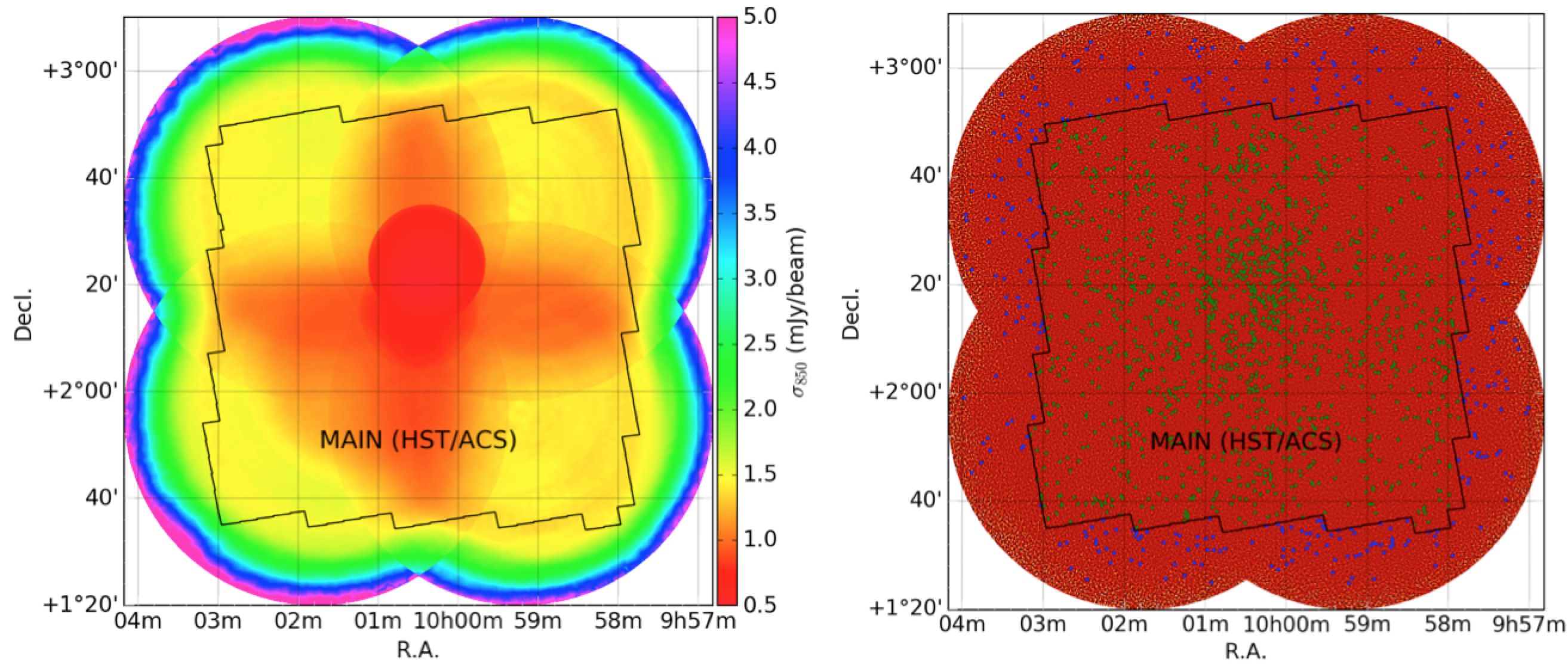eS2COSMOS
eS2COSMOS is an extension of the original S2COSMOS program. The aim of eS2COMSOS is to create the deepest, wide-field image at 850um in the key extragalactic survey field, COSMOS. Building upon the legacy of the now complete EAO/S2COSMOS survey we aim to reach a 1-sigma noise level of 0.9mJy/beam across 2 sq. degrees (thus approaching the JCMT confusion limit at 850um) and thus uncover over 2,500 SMGs. With this new sample eS2COSMOS will address a range of key questions regarding obscured activity, not least regarding the evolution of SMG clustering across cosmic time.
S2COSMOS
S2COSMOS is a completed 223hr EAO Large Programme on the JCMT whose goal is to create the largest, contiguous deep 850μm map of the extragalactic sky – in the 2 square degree COSMOS field. COSMOS is the pre-eminent ALMA-visible, degree-scale extragalactic survey field.
The key feature of S2COSMOS is the combination of both a deep and a panoramic submillimetre map of the complete COSMOS field. Our goal is to obtain a sample of >>1,000 submillimetre sources in this field to a flux limit of ~4-5mJy (corresponding to a bolometric luminosity of 5 ×1012 L¤). To achieve this S2COSMOS builds upon the inhomogeneous coverage of the COSMOS field provided by the SCUBA-2 Cosmology Legacy Survey (S2CLS; σ850 ~1.5-5mJy, Geach et al. 2017) to create a uniform σ850 ~1.2mJy rms map of the entire field.
The survey has made good progress and as of January 2017, 79% of the time allocation has been used. Data reduction and analysis is being led by survey scientist James Simpson at ASIAA/NAOJ, and a version 1.0 map and source catalogue have been released to the S2COSMOS consortium.
The current version of the S2COSMOS map (see figure) reaches a depth of <1.6mJy across the full 2 square degree COSMOS field, completes the first phase of our survey; to homogenise the existing coverage, including the archival observations. The remaining 21% of the S2COSMOS time allocation will now be used to increase the overall depth of the field, with a focus on ensuring the coverage remains homogenous. The final set of S2COSMOS maps and data products will be released to the community at the end of the project, expected to be mid-2018.

Left: The combined S2COSMOS coverage map of the full 2 square degree COSMOS field, including all data taken as of February 2017 (new+archival). The S2COSMOS map reaches a depth of σ850 3.5σ that lie within the HST/ACS coverage (MAIN sample) and a further 398 sources (blue) at a SNR>3.5 σ that lie outside this uniform coverage region but that have Spitzer/IRAC coverage (SUPP; σ850<4mJy). We predict that when completed our survey will yield a sample of >2000 submillimetre sources across the full COSMOS field.
Using the current S2COSMOS map we define a MAIN sample of 850μm sources that are located within the HST/ACS coverage of COSMOS. There are 1530 MAIN catalogue sources within the HST/ACS region (defined as having σ850 <1.6mJy and >3.5σ significance), along with a further 398 supplementary (SUPP) sources that lie outside this footprint but within the Spitzer/IRAC imaging (σ850 <4mJy and >3.5σ significance). Based on the current source density we expect that the completed S2COSMOS survey will locate >2000 submillimetre sources across the COSMOS field.
The availability of this uniquely large sample of 850μm-selected submillimetre sources in a single field with superb supporting multiwavelength data will provide the opportunity to address a wide range of science questions relating to submillimetre galaxies. The final S2COSMOS map will span twice the area of similar surveys in a single contiguous field, allowing unique tests of the clustering of the submillimetre galaxy population on scales up to ~60 Mpc. Furthermore, conducting sensitive stacking analyses will unveil the far—infrared properties of a huge range of populations in this very well studied field.
Coordinators: Scott Chapman (CA), Yuichi Matsuda (JP), Ian Smail (UK), Ran Wang (CN), Wei-Hao Wang (TW), Yujin Yang (KR)



